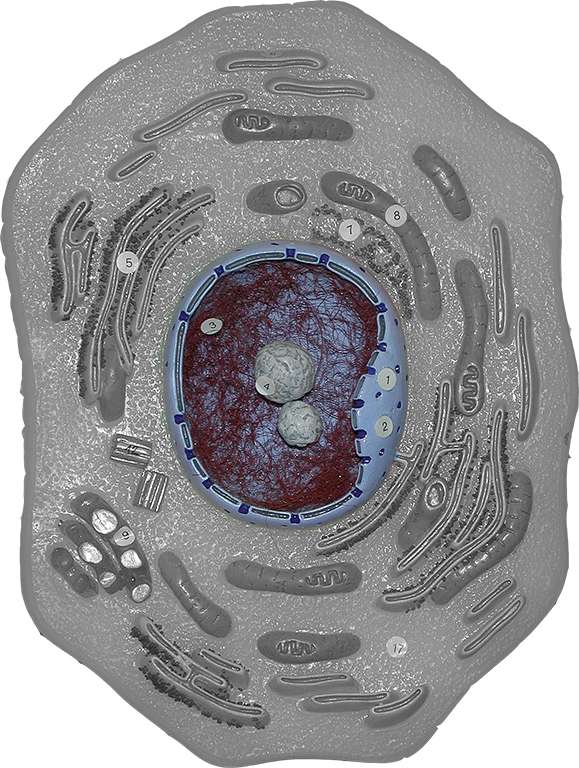Nucleus
|
|
The nucleus is a large membrane-bound organelle within the cell that contains the cells DNA , or genetic material. The image to the right is an edited photograph of one of the animal cell models we have in lab. The structure highlighted in blue is the nucleus. In this cell, as in many other cells the nucleus is located in the middle of the cell.
, or genetic material. The image to the right is an edited photograph of one of the animal cell models we have in lab. The structure highlighted in blue is the nucleus. In this cell, as in many other cells the nucleus is located in the middle of the cell.
The membrane surrounding the nucleus is called the nuclear membrane or nuclear envelop. This membrane has many six sided pores called nucleopores that allow information molecules (remember we copy information from the DNA template) to move from the nucleus to the cytoplasm.
The nucleus is filled with nucleoplasm. The nucleoplasm is jelly-like and very similar to cytoplasm in its consistency. Suspended within the nucleoplasm are the nucleoli and the chromosomes. Nucleoli (nucleolus, singular) are the sites of ribosome production. Ribosomes are the workbenches of protein synthesis and will be discussed more later. For now, it is sufficient to say that they are produced in this region of the nucleus. Within the nucleoli you would find the RNA and protein needed for the production of the ribosomes.
All of the information a cell needs to function is stored in our genetic molecules or in our DNA. Your DNA is the master set of instructions, the blueprint or the play book for making you, you. Our genetic information is organized in the form of chromosomes. Humans have 46 chromosomes. We have 23 pairs of chromosomes. Chromosomes 1-22 are called autosomes and the last pair are the the sex chromosomes. We inherit one chromosome of each pair from each of our parents. So your Dad contributed 23 chromosomes in his sperm and your Mom contributed 23 chromosomes in her ovum to create you. Each chromosome contains a number of genes. A gene is a short coding segment of DNA. The classic definition is a gene is sequence of bases in the DNA that code for a specific protein.
When we think about chromosomes we usually visualize linear X structures. That is what chromosomes look like when a cell is ready to divide and the DNA is condensed. Most of the time however DNA is not condensed. It is all stretched out in a long stringy molecule. The cell uses the information stored in the DNA constantly, like a reference book or google search. Whenever the cell needs another protein to do a specific function it goes back to the DNA reference book copies the information out and then sends the instructions to the cytoplasm. The information stored in the chromosome can only be retrieved when the DNA is long and stringy. The information is not accessible when the molecules are condensed. The long stringy form of chromosomes is called chromatin. The chromatin is indicated by the red strings seen in the nucleus in the image. Keep in mind that the DNA ALWAYS stays in the nucleus. Like a precious reference book, the DNA is not allowed into the cytoplasm where it could be 'lost' or 'broken'.



